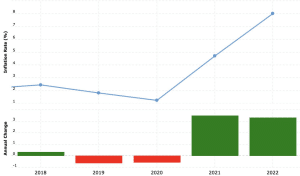Now legendary Democratic Party strategist Jim Carville raised an interesting point in 1992 – It’s the economy, stupid! Of course, he referred to the most pressing reason voters choose one candidate over another. At its most basic level, voters are inclined to support the candidate promising as much economic relief as possible.
Scant attention is paid to the rationale behind the policies or who ultimately bears the burden of tax breaks, write-offs, giveaways, and other government-supported economic initiatives. There has been a paradigm shift in economic prosperity since 2016. Two presidents with contrasting policies have held office in the United States – Trump and Biden. The fluctuating fortunes of the US economy fall squarely within the domain of the Oval Office and the policies it sets for the next four years.
Experts routinely cite facts and figures to support policy decisions. Inflation is one of the most critical metrics policymakers use to woo voters. At its most basic level, inflation is defined as the change in the price of a basket of goods and services over a period of time, typically one year. It is an important metric because it reflects what is happening with the purchasing power of a dollar.
When we speak of money, there are two values: the nominal value (the value printed on the currency) and the real value (purchasing power adjusted for inflation). In economic terms, only the real value matters because it is the only meaningful metric. In an inflationary economy, increasing nominal GDP means absolutely nothing.
The real GDP has meaning—consumer spending reluctance or cautiousness points to the same reality. People don’t want to spend money now because they can’t afford it or because it’s too expensive to pay for things with high interest rates on repayments.
Innovative Ways to Tackle A Consumer Spending Downturn

From a microeconomic POV, small businesses can participate in various local, regional, or national initiatives designed to help consumers. Several innovative solutions exist and are already making a dent in the runaway prices that consumers are subject to. Business practices can profoundly impact relationships within communities with local manufacturing, sourcing, and distribution networks. More importantly, consumers are price sensitive. If macro trends prevent price decreases, micro-practices can turn things around for the long-term sustainability of SMBs.
Something as simple as a proven cash back app for consumers has profound potential. When businesses in similar industries band together (perhaps restaurants, grocery stores, and gas stations) en masse, they create an attractive network for consumers vis-a-vis rewards programs.
Ideally, cashback services should be easily and freely accessible and partnered with various businesses to ensure choice, need satisfaction, and reward potential.
Such services exist across the board, with many leading businesses in towns and cities across America. These types of practices benefit stakeholders across the spectrum since deeper and more meaningful bonds are forged between consumers and companies, leading to increased cash flow, reliable ROI, enhanced community engagement, and more sustainable business models.
Macroeconomic Tools and Resources
We must look at the country as a whole to get the macroeconomic perspective. The Conference Board’s ECI (consumer confidence index) for August 2023 increased to 103.3, with a base year of 100 in 1985. The July figure was revised higher at 101.9. This indicates a slight improvement in sentiment vis-a-vis the business and labor market. While there is a small uptick, it remains within a narrow range of suppressed sentiment.
Although people are slightly more optimistic about the country’s future direction, many are less than comfortable about the situation. Individuals 35 and younger are more pessimistic, while those 35 and older are more optimistic. This paints an interesting picture for the broader economy since it warrants concrete steps for improvement.
The Fed is the most crucial independent authority capable of influencing monetary policy. Recall that fiscal policy is the government’s domain and it encompasses Congress and the Executive branch. Government spending and taxation are instruments of fiscal policy. Runaway inflation can be combated by fiscal or monetary, or both types of policies. The Fed has many tools in its arsenal from a monetary policy perspective.
These include interest rate manipulation (raising or decreasing), mandating reserve requirements for banks, QE policies (quantitative easing and quantitative tightening), and open market operations. All of these actions are designed to influence the money supply. When there is too much money in the economy, inflation runs rampant. Reducing the money supply (through tightening measures) means less money exists, demand declines and prices theoretically come down.
That’s the nuts and bolts of micro and macro policies designed to offset downturns in consumer spending. If implemented correctly, these measures can have a profound impact on economic fortunes.


